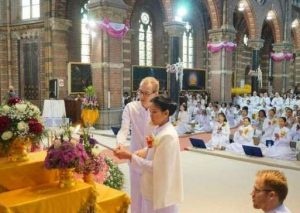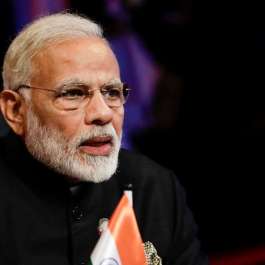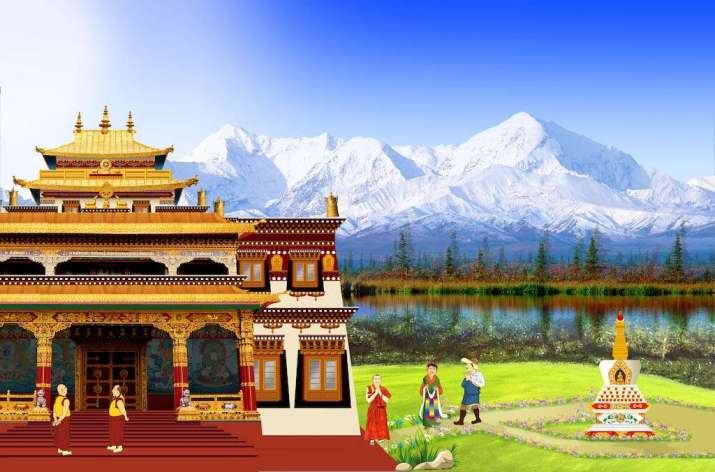
Graham Coleman is the chief executive of the Orient Foundation for Arts and Culture, which was founded in 1983 and focuses on multimedia documentation of resources on Classical Indian and Tibetan knowledge, and developing regional and international access to such resources. In this interview, he discusses perhaps his most ambitious project yet: Gompa, a platform connecting monasteries and nunneries in India and Nepal, followers around the world, and all those with an interest in Tibetan knowledge, practice, culture, and arts.
In partnership with more than 45 monasteries and nunneries, the services provided by Gompa so far include year-round high-production-quality webcasts of teachings by eminent rinpoches and senior lamas, an online arrangement of prayers and pujas, and an online service for making offerings and donations to the partner monasteries and nunneries with no transfer fees.
Gompa provides services monasteries and temples of all of the major traditions of Tibetan culture—Nyingma, Kagyu, Sakya, Gelug, Jonang, Bon, and Rime.
The advisory council is composed of: His Holiness the Gyalwang Karmapa, His Holiness the Gongma Trichen Rinpoche, His Holiness the Drikung Kyabgon Chetsang, His Holiness the 34th Menri Trizin, His Excellency Kyabje Ling Rinpoche, His Excellency Minling Khenchen Rinpoche, and His Excellency Choekyi Nangwa Rinpoche.
Buddhistdoor Global: Can you describe a bit of the background in which you came to begin Gompa?
Graham Coleman: Beginning in 1976, I spent three years writing and directing a feature documentary, Tibet: A Buddhist Trilogy, which was released in 1979 and played in cinemas around the world. Over the period of making the Trilogy, I was fortunate to have formed strong relationships with many senior lamas across India and Nepal. In 1983 the Orient Foundation was formed and we began documenting the oral teachings given by senior lamas in universities and centres internationally.
Ensuring the continuity of the oral commentarial traditions, which have been handed down from master to student since ancient times, is a major part of ensuring the continuity of the Tibetan cultural heritage and the monastic curriculum: as many classical texts are written on the assumption that they would be taught together with their oral commentary. The continuity of this pedagogical method, of course, was not a certainty.
In 1993, therefore, the Foundation set up multimedia recording centres at the major monasteries in order to document the oral commentaries to the major classical texts. Over the years, senior lamas of all traditions have also donated their own recordings to the archive. The Classical Tibetan Knowledge Archive and Multimedia Study Resource is now one of the largest multimedia archives of Tibetan cultural resources in the world. Currently, the archive includes more than 22,100 hours of recordings of oral commentaries to the key classical texts of Indo-Tibetan culture by many of the greatest masters, scholars, doctors, and artists of the 20th century, most of whom completed their studies in Tibet before 1959.
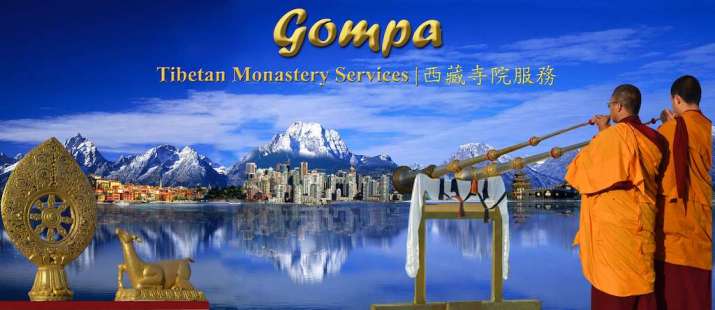
With the advancement of technology and globalization transforming the relationship between teachers and students, senior lamas began to ask us how we might help to build a closer relationship with their followers worldwide through technology. After extensive consultation, the collective decision was made to work in partnership with as many as possible of the major monasteries and nunneries to create the Gompa online services project, and we have been working on setting up the infrastructure for Gompa for the past four years. The English language version of Gompa has now been launched and a Chinese-language version is being developed. We are at present in the publicity stage, letting people know that we exist and that the Gompa online platform is available for use.
BDG: How would you describe the concept of Gompa?
GC: The main objective of Gompa is basically to serve as an online simulacrum of an environment where people feel like they live near a monastery or nunnery. Effectively, it is a digital re-creation of a traditional Tibetan community. It addresses the question: “How much of this ancient relationship between a town or village and its local monastery or nunnery can be reproduced at a global level?” At first we had in our mind that Gompa would mainly serve “foreign” or Western devotees, or non-Tibetans, non-Nepalese, and non-Indians. But then we realized that members of the Tibetan diaspora, together with “foreigners”, are using Gompa much more than we expected, which is very pleasing.
The teachers, monks and practitioners of the member monasteries also find that the opening of their services to people around the world is transforming their visibility and the number of people that they can benefit. It also saves time, energy, and travel expenses, especially on the part of the older lamas who used to have to travel around their region or the world. Now, even teachings given in remote locations are accessible on Gompa.
BDG: What would you say your general role is in Gompa?
GC: At a general level, I want us to always play the role of a supporter. I am deeply appreciative of the support for Gompa and the trust in Gompa given by the senior lamas. From our side, I think it is crucially important that we are always very sensitive to the traditional relationship between the monasteries and their followers and that we carry out our work with the motivation to serve the senior lamas and all those responsible for the administration of the partner monasteries and nunneries.
Personally, after having worked mainly on establishing the working relationships between the monasteries and nunneries and Gompa, the training of our Tibetan webcast crews, and managing the building of the Gompa site, I now mainly make sure that all scheduled events are planned and happen on time and that our webcast announcements are developed together with and approved by the partner monasteries and nunneries. I also help with writing descriptions of the webcasts and editing them before they are uploaded. There’s a lot of keeping up with multiple schedules of important teachers. We are always looking six to nine months ahead with each partner, so you can imagine how full our calendars can be.
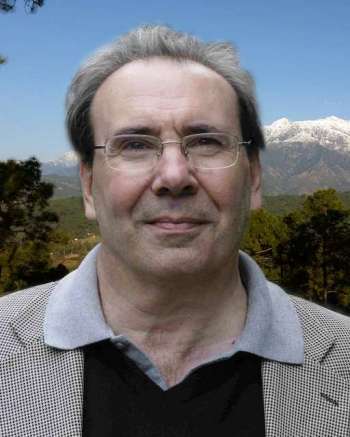
I also would like to highlight a new, unique service which we plan to launch later this year, called the ‘Diamond Path’ service where followers can pre-arrange for the pujas to be performed that they would like to make sure are performed at the time of their death. We are establishing this service in partnership with Ecclesiastical Insurance in the UK, which was founded in 1887. Ecclesiastical Insurance will hold the follower’s maturing fund, which can be built up in instalments over a number of years. The fund will then be transferred to the monastery or nunnery of the follower’s choosing immediately upon notice of passing. All that is needed is for a registered relative to give notice and the sponsor’s requested pujas can then be performed without any delay. For their part, the selected monastery or nunnery can therefore, as is traditional, instantly assign monks or nuns to perform the sacred rituals and prayers. As you know, it is very important for the pujas, especially Powa (transference), to be performed as close to the time of death as possible.
BDG: Looking ahead, what do you see as opportunities and ideas for implementation?
GC: Stable 4G connectivity throughout many parts of India and Nepal is not far off, and then we will be able to offer truly live webcasts. Because we webcast in HD there is currently a short time difference between the recording of the webcast and the availability of the webcast on Gompa, due to the time it takes to upload the large HD files. As now, all webcasts will always remain available to view at any time of the viewer’s choice for at least 2 weeks from the time of the live recording, to allow for the time zone of the viewer and also to give plenty of time to view longer teachings at times most convenient for the viewer. However, it would be ideal if webcasts of empowerments, for example, could be truly live and, in general, there is an added sense of immediacy when a webcast is truly live.
I am so grateful for the support and generosity that the senior lamas have shown towards Gompa. Administering a unique website such as this, with connections to so many monasteries and nunneries, is quite different compared to filmmaking or writing. However, our team—all Tibetans on the ground—has been amazing, working independently, and preparing for and recording the webcasts professionally. So far, I am very happy with what we have accomplished together.
I profoundly believe in the value of the monastic tradition. The monasteries and nunneries are the repository of very profound understandings concerning the nature of mind, our human condition, and humanity’s relationship with the world. I hope that through Gompa we can help the monasteries and nunneries gain exposure and also increase support for their educational and social welfare projects. It is the wish of all those involved with establishing the Gompa partnership that people may find that Gompa can help to maintain a truly close connection with a monastery and nunnery and its masters, wherever they are.
See more
Gompa: Tibetan Monastery Services
Graham Coleman: Preserving Tibetan Culture in the Digital Age (Wisdom Publications)










